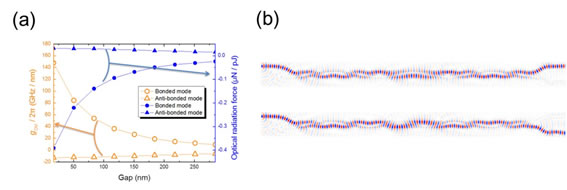Proposal for optical path conversion application using silica ZIPPER-type optical resonators
Research
Proposal for optical path conversion application using silica ZIPPER-type optical resonators
Toward a New All-Optical Switch Operated by Optical Radiation Pressure
Since light has momentum, it generates pressure when it strikes a material. This pressure is called optical radiation pressure, but it has rarely been used in device research because it is an extremely weak force. However, with the recent development of micro optical resonator technology, the research field of optomechanics, in which the optical radiation pressure is efficiently increased to control the resonator structure, has developed. We have theoretically investigated a new all-optical switch based on optical radiation pressure using a silica zipper-type optical resonator.
The silica zipper optical resonator consists of two nanobeam optical resonators in close proximity as shown in Fig. 1 (a). the Zipper resonator confines and enhances the light at its center, generating strong optical radiation pressure between the two bridging structures. When the radiation pressure is sufficiently strong, the resonator structure is displaced and the spacing between the two nanobeam resonators changes. We considered using this behavior in a dynamically controllable directional coupler. A directional coupler is a device used for combining and dividing light with two optical waveguides in close proximity, and can be used to change the path of light by appropriately changing the spacing between the waveguides (Fig. 1 (b)). By replacing this waveguide with a zipper resonator, it is possible to realize an optical path-changing switch that operates by changing the waveguide spacing by optical radiation pressure. This is the first all-optical switch driven by optical radiation pressure in the world, and we have named it a MOMS (Micro Opto-Mechanical System) switch.

Fig. 1 (a) Schematic diagram of zipper cavity. (b) Schematic diagram of light propagation in directional coupler waveguide.
Silica was selected as the resonator material for the numerical analysis of the design and performance of the MOMS switch. Silica is less rigid than other optical materials, making it suitable for applications requiring large structural displacements. In addition, taking advantage of the wide wavelength range available, we chose the visible light band for the control light and the telecommunication light band for the signal light. In this way, the signal light can propagate without being affected by mode localization due to the Bragg mirror.
Since the resonance frequency changes adiabatically when the resonator structure is moved by optical radiation pressure, the optical radiation pressure can be calculated from the dependence of the resonator internal energy U (resonance frequency ω) on the displacement distance s (dU/ds = ħdω/ds). We calculated the optical radiation pressure generated by the FDTD method to obtain the resonance frequency when the resonator spacing is varied (Fig. 2 (a)). We also calculated the displacement of the resonator structure when the optical radiation pressure is applied to it using the finite element method. Furthermore, the performance of the structure as a directional coupler before and after displacement was evaluated using the FDTD method, and in comparison with the aforementioned results, it was shown that an optical path conversion with a large extinction ratio of over 17.8 dB was possible with a control light input of 190 mW (Fig. 2 (b)).

Fig. 2 (a) Gap dependence versus opto-mechanical coupling rate and optical radiation force. (b) Light propagation of the initial state (gap = 194 nm, (b) Light propagation of the initial state (gap = 194 nm, extinction ratio (ER) = 17.8 dB) (upper) and light propagation after deformation (s = 93 nm, ER = 18.2 dB) (lower).
- Categories
- 研究トピックス



